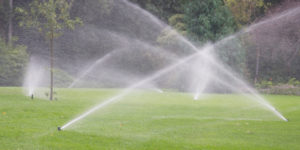The sprinkler system is one of the least examined yet potentially expensive systems in a home or on an HOA property. There are several reasons why taking a look at the system can save you money and future headache.
Two major types of troubleshooting will be covered in this article. Troubleshooting for a problem with the system, and troubleshooting for reducing water usage. How to know when troubleshooting is necessary? Anytime the system is not working like it used to, or anytime changes in landscape occur, or water bills leap. There is no harm in proactively checking your sprinkler system, or having a licensed professional do that for you.
Troubleshooting for problems
Problems with sprinkler systems typically fall within two areas of concern. The first concern is the system simply won’t run. When this happens, put on your Sherlock Holmes cap, and eliminate everything that isn’t the problem. Follow this order:
1) Confirm the easy stuff –
- does the controller have power? Check the plug by plugging in a hair dryer or some other appliance that you know works.
- Does the system have water? Check the water meter and doublecheck valve to make certain the water wasn’t inadvertently turned off.
2) If both of the above are in order, check the controller again.
- Is the time and date correct? Power loss can make schedules be off kilter
- Check the schedule. Are the water days what you think they are? Are they following your city’s regulations?
- Will no zones run, or just one zone or a couple? One zone not running could indicate a failed valve or cut zone wire. All or several zones not running indicates a cut common wire. Check any areas where digging, fence repair, dog watch fence installation, or any soil disruption has occurred for broken wires.
3) Have a leak? Follow these steps to identify the problem
- Does the leak flow all of the time, or just when a particular zone is running? This means the difference between a mainline leak (leaking all the time) and a lateral line leak (runs only when that zone valve is actuated. Both are emergencies, but if it is a mainline leak and your system is not equipped with a shutoff valve, call a licensed irrigator right away.
- Is an emitter off? Lawn mowers and edgers can nick a nozzle, cut drip line, or break a head at the bottom connection. Components can also be broken by bikes or skateboards, dog leashes, or being run over along driveways. Sometimes the part can be reattached but more times than not it will have to be replaced. Requesting swing joints on all repairs can make future problems less likely, particularly in high traffic (foot or vehicular) areas..
4) Really dry spot? Sometimes this indicates a leak as well. It sounds counterintuitive, but if a head or pipe is broken on the same zone on the other end of a flower bed, water follows the path of least resistance, which can cost pressure on the other end of the zone. Turn on that zone to check that every emitter is working consistently.
5) Know when to call in back up — once you find the issue, hire only a licensed irrigator to make the repair. Having a technician you know and trust in advance will help. He or she should offer proactive service while they are on-site by checking the whole system for other issues while they are there making your repair. Ask questions about your watering schedule, and learn how to run your controller.
Most property owners never see their irrigation systems run, and their only indication that there is a problem is suffering landscape, or a high water bill. Here are some troubleshooting steps that can be taken to ensure water use is appropriate for your landscape.
1) Check the meter first. Almost all meters have a leak indicator. This is typically a small arrow or triangle meter located in the screen of the water meter. Confirm there is not water running in the house (washing machine, dishwasher, etc) and check the leak indicator. If it is moving, there is a water leak somewhere.
2) Bills creeping up each year? Municipalities are increasing water rates year over year. If no maintenance has been done other than repairing breaks in several years, your system could be wasting water. Running each zone periodically, at least seasonally, recommended monthly, will show if there are broken components, mismatched coverage, or needed improvements.
- Check the schedule. As plants in the landscape have active growing times of the year as well as dormant months, so your irrigation schedule should “change with the times”. Ideally, you or your yard guy should be adjusting your sprinkler schedule way down as it gets colder and up as spring and summer arrive. Not sure what to do? Check watermyyard.org for weekly updates about watering.
- Has your landscape changed? Anytime changes occur in the landscape such as new sidewalks, expanding flower beds, or new plantings, irrigation should be moved and changed to match the new layout. This will help ensure that the right water is being applied to the right plants, and that nothing was damaged during the project. A good rule of thumb is to budget 20% of the total landscape project price to irrigation changes.
- Taken care of all of the above and still unhappy with your water bill? Take a look at these items, or get professional licensed help to upgrade to conservation technology.– Pressure issues-irrigation components are designed to perform efficiently under a specific range of pressures. Once this pressure is exceeded, water use rises exponentially. To exacerbate pressure issues, cities ramp pressures seasonally to be able to keep up with increased demand. Contact a licensed irrigator to test your head pressure and prescribe possible solutions.– New nozzles-if the nozzles on your sprinkler heads are more than a few years old, it is likely that more efficient nozzles are available to increase uniformity, repair design inefficiencies, or control the pattern better to increase overall efficiency.
– New heads. Sprinkler heads typically carry a 5 year warranty. After 5 years, the rubber in the head’s seal begin to breakdown due to sun damage and chemical exposure. Once the seals begin to weaken, water can leak at the base of the head every time the zone runs.
– Upgraded heads-if your property has sloped areas, or if you have excessive pressure, upgrading to pressure regulated or check valve equipped heads can dial back water waste.
Smart controller-new technology allows controllers to have web-based remote access, automatic adjustments based on the weather, and other water conserving features. Upgrading to a new controller can save money and water by watering on a more precise schedule, improving landscape and using less water.– Drip-converting bed areas to drip irrigation can eliminate overspray on windows and hardscapes, and once properly scheduled is the most efficient way to water, delivering water to the soil profile and not overhead where it can be susceptible to blowing away in the wind, deflection, or over spraying on other areas.
– Landscape choice and soil conditions-the changing nature of water in Texas has caused many citizens to look at their plant palettes. Adaptive and native plants are the best choice for conservative water use. As existing landscapes approach the end of their lives, consider replacing with less water thirsty plants. In addition to plant choices, the condition and quality of soils are key in water retention and usage. Eliminating salt based synthetic chemicals, and adding organic matter such as compost to feed microorganisms in the soil will help build a healthy soil that will be more disease resistant, retain more water, and encourage healthy root growth.
– Mulch-keeping planting beds insulated with at least 2 inches of twice shredded, hardwood mulch, helps retain water, reduce evaporation, and shades root zones. Have 3 inches installed in the spring, taking care not to choke the crown of plants, so even if a small layer gets blown away through maintenance, your beds will still be insulated from the heat.

